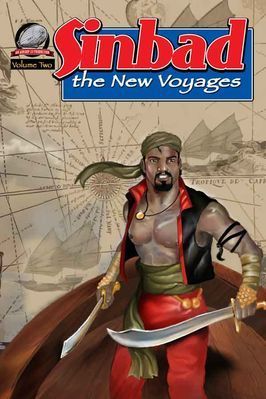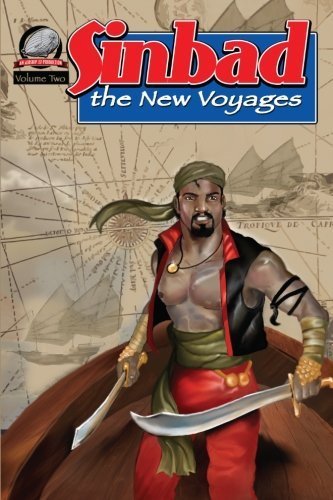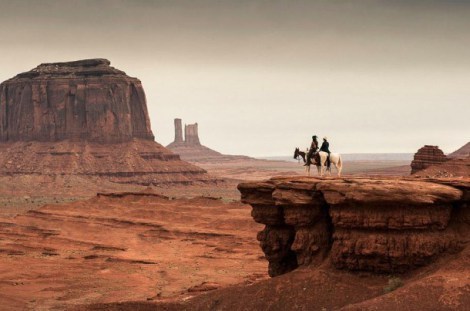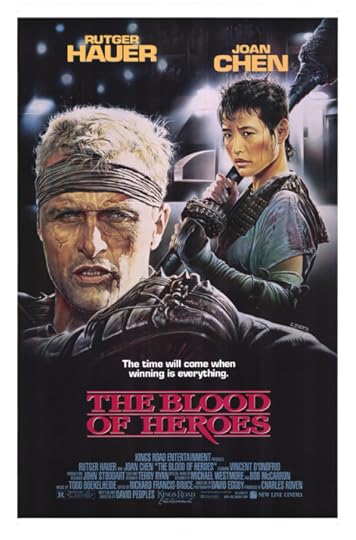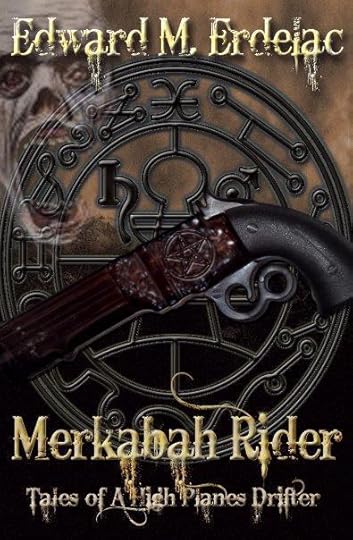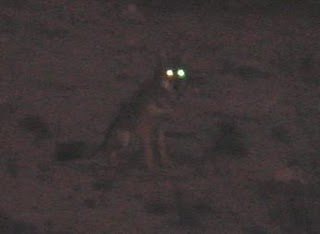Edward M. Erdelac's Blog, page 27
August 9, 2013
DT Back Issues Index
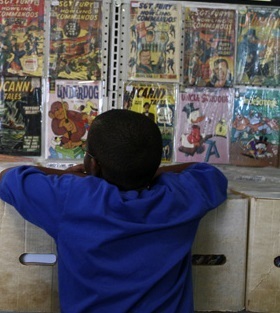 1983-1995 (the Copper Age) was the height of my comic book collecting, and a great time to discover the medium. Starting with Larry Hama’s GI JOE: A REAL AMERICAN HERO for Marvel and gradually segueing into TRANSFORMERS and GROO THE WANDERER, I started frequenting comic shops and began to pick up anything that caught my eye. The mid 80′s saw the release, in rapid succession, of Frank Miller’s WOLVERINE (with Chris Claremont), DARK KNIGHT RETURNS, Alan Moore’s V FOR VENDETTA, THE WATCHMEN, and THE KILLING JOKE, and other positively seminal works in the field.
1983-1995 (the Copper Age) was the height of my comic book collecting, and a great time to discover the medium. Starting with Larry Hama’s GI JOE: A REAL AMERICAN HERO for Marvel and gradually segueing into TRANSFORMERS and GROO THE WANDERER, I started frequenting comic shops and began to pick up anything that caught my eye. The mid 80′s saw the release, in rapid succession, of Frank Miller’s WOLVERINE (with Chris Claremont), DARK KNIGHT RETURNS, Alan Moore’s V FOR VENDETTA, THE WATCHMEN, and THE KILLING JOKE, and other positively seminal works in the field.
But I don’t wanna talk about them. I’m by no means a scholar or expert. I got out of comics for the most part when I started college, only popping in now and then since to pick up the occasional trade collection, LEAGUE OF EXTRAORDINARY GENTLEMEN, SIN CITY, THE WALKING DEAD, a couple CAPTAIN AMERICAs, THE ULTIMATES, stuff like that. All those books have been written up and dissected by far more qualified people than me, and you can look them up anywhere on the internet.
I’ve decided I’d like to revisit comics I’ve kept in the long white boxes in the back of my closet, titles that for whatever reason may not have been the most popular, and indeed, were likely forgotten for the most part, or mostly went underappreciated. I don’t know that I’m talking about rarities, or anything. I wasn’t really an underground comics guy. I’m talking more about mainstream gold that for whatever reason floated off down the creek. Stuff like Andy Helfer’s take on THE SHADOW, THE LAST AMERICAN, MARSHAL LAW, Steve Gerber’s FOOLKILLER miniseries from the 90’s, John Wagner’s BUTTON MAN, and Evan Dorkin’s MILK AND CHEESE.
So this is the index of all the comics I’ve taken a look at in the DT: Back Issues feature of my blog, much the same as the one I did for DT MOVIEHOUSE. It’ll give you something to read about besides Merkabah Rider, the Van Helsing Papers, Buff Tea, and anything else writerly I’ve got coming down the pipe.
Button Man
The Last American
The ‘Nam
The Shadow


August 8, 2013
Sinbad And The Sword Of Solomon in Sinbad: The New Voyages Vol 2
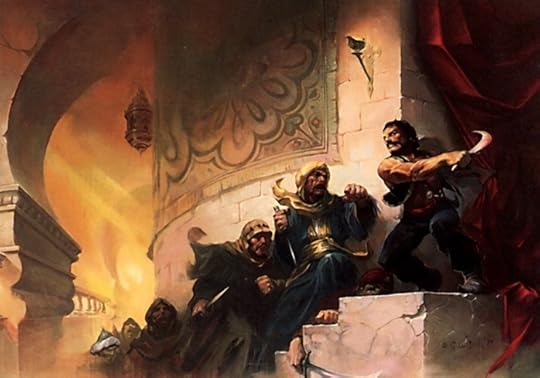 I love Arabian Nights, sword and sorcery, Thief of Baghdad, and the stop motion works of Ray Harryhausen. If you do too, you’ll probably get as much of a kick reading my novella Sinbad and The Sword of Solomon as I had writing it. It’s appearing in volume 2 of Airship 27′s Sinbad: The New Voyages series, alongside stories by Shelby Vick and Erwin K. Roberts, and featuring illustrations by Steve Wilcox.
I love Arabian Nights, sword and sorcery, Thief of Baghdad, and the stop motion works of Ray Harryhausen. If you do too, you’ll probably get as much of a kick reading my novella Sinbad and The Sword of Solomon as I had writing it. It’s appearing in volume 2 of Airship 27′s Sinbad: The New Voyages series, alongside stories by Shelby Vick and Erwin K. Roberts, and featuring illustrations by Steve Wilcox.
Airship 27′s take on Sinbad is pretty cool. I love researching and writing about the coming together of various cultures. Merkabah Rider is full of culture clash. In this incarnation, Sinbad’s most trusted crewmembers are culled from his various adventures around the world. There’s Henri Delacrois, a rogueish archer from Gaul, Ralf Gunnarson, a towering Viking youth, Tishimi Osara, a Japanese swordwoman, and the put upon first mate of Sinbad’s fantastic ship the Blue Nymph, Omar.
My own story sends Sinbad on a quest to a remote island surrounded by a magic, ship-smashing storm in search of the mystical sword of King Solomon, forged by a demon, and capable of inflicting wounds which cannot be healed. There’s a giant metal skinned demon, a savage tribe of mermen, marooned Maori warriors, and a ship on the back of a giant white roc.
Here’s an excerpt -
The greatest sea port in the Arab world was Al-Basra, the place where many paths met.
And among the many dhows bobbing in the harbor, the greatest of them all was the Blue Nymph.
 She was ostensibly a baghlah, one of the intrepid shallow draft ships whose sharp bows and lateen sails allowed them to outpace the turgid monsoons that plagued the Indian Ocean upon which they plied their prosperous trade. But her type would remain unmatched and unseen in those waters for centuries, for her exact specifications, which some covetous sailors whispered must have been divinely inspired by the Lord of All Waters Himself, were entirely of original design. She had been so heavily modified and refitted under the direction of Sinbad and Omar, that she barely resembled any ship sailing the seas. She was not sewn together with fibers, as was the preferred method among Arabian shipwrights. Her strong Ethiopian teakwood planks were mysteriously joined by twinkling metal fasteners. It was a technique Sinbad and Omar had learned from the Viking shipbuilders, and was practically unknown in this part of the world.
She was ostensibly a baghlah, one of the intrepid shallow draft ships whose sharp bows and lateen sails allowed them to outpace the turgid monsoons that plagued the Indian Ocean upon which they plied their prosperous trade. But her type would remain unmatched and unseen in those waters for centuries, for her exact specifications, which some covetous sailors whispered must have been divinely inspired by the Lord of All Waters Himself, were entirely of original design. She had been so heavily modified and refitted under the direction of Sinbad and Omar, that she barely resembled any ship sailing the seas. She was not sewn together with fibers, as was the preferred method among Arabian shipwrights. Her strong Ethiopian teakwood planks were mysteriously joined by twinkling metal fasteners. It was a technique Sinbad and Omar had learned from the Viking shipbuilders, and was practically unknown in this part of the world.
The Blue Nymph’s rippling canvas was dyed sky blue, a vanity of Sinbad’s, but one which also served to keep all but the most daring of the Bawarij corsairs away as his fierce reputation preceded him. She could, at an order, raise a jib on her bowsprit, or supplement her main from the topmast, and with the blessing of the wind she could attain a speed unmatched.
Her gloriously ornate stern had been carved by a master woodworker and his son for a sultan’s ransom. It depicted a beauteous, full bodied, mermaid, smiling impishly, her circling black hair writhing like serpents, as if captured underwater, her scaly tail curling upwards mischievously, as if beckoning her pursuers on. All around her were seven starfish, representing the seven seas her captain had conquered. Her two shining eyes were crystal blue and composed of great globes of inset glass, though some swore they were two great jewels Sinbad had procured in his travels. Whatever their make, they gave the appearance of two mighty nazar charms, twice warding the ship against the evil eye.
To see that flirtatious, mocking smile recede, to hear the crack as the wind caught her lovely blue sails, to see the ocean split before her and to be left bobbing in the white foam of her powerful wake, that was a heartbreak to many a sailor who had never set foot upon her.
But to the twenty five lusty men who sang heartily as they lovingly scrubbed her decks and wove and tarred her rigging beneath the sun, she was the greatest home many of them had ever known. Her captain did not allow just any sea rat to set an unworthy heel upon her decks, and to be a member of that immortal crew was almost to be beloved in the eyes of Allah. No shirkers there, for broad-shouldered Omar would toss a fool overboard by his ear, and to be thrown off the Blue Nymph was a greater curse than to be denied her decks, because who would employ a fool that had attained that august company and been cast out?
No coward either, for all knew that wherever the captain of the Blue Nymph pointed her prow there would be death and danger enough for a fleet of such vessels. But even the most pitiable jellyspine pined for one such voyage with Sinbad the Sailor. All knew men who had returned from his journeys and retired young to lives of luxury, bolstered by unfathomable riches which their generous master always paid out to any who would quit the sea.
But some never quit.
Sinbad and his companions were such. For them, the sea was their greatest love. That boundless blue plain pulled their souls, and would not release them until their bodies gave up the tug of war at the end of their days and the waves rolled over the only graves they would ever know.
There were others too.
Like young curly headed Haroun, a penniless bastard, a son of bastards, with the name of the caliph of Baghdad, who secretly thought himself more fortunate as a member of the Blue Nymph’s crew.
The youth sat in a sling dangling over the stern with buckets of paint, touching up the blue and gold gilt work of the Blue Nymph’s namesake. He turned and flashed an ecstatic smile at the appearance of Sinbad, striding down the dock like a sable emperor, his blue silken shirt and the embroidered pantaloons tucked into his rich Kurdish boots rippling in the ocean wind, the familiar red cloak billowing out behind him.
Sinbad saw the young sailor at the same time and returned his smile as he reached the foot of the gangplank.
“Ho! Haroun!” he tossed a red apple up to the boy.
Haroun caught it and raised it in thanks.
“How does she look, O Captain?”
Sinbad put his fists on his hips and took in not just the boy’s touch up work, but the entirety of his beloved craft. He felt his heart swell within his chest. There was but one thing he loved more than the sea and that was this magnificent craft that carried him across it.
“Beautiful,” he answered, and ascended the bouncing gangplank.
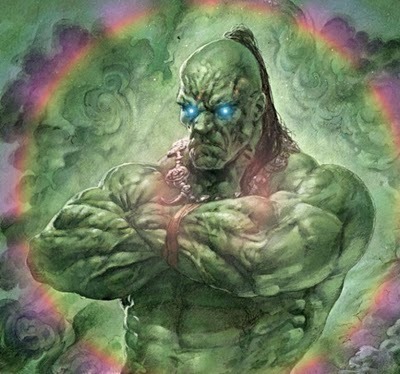 Sinbad: The New Voyages Volume 2 has set sail! Pick it up here -
Sinbad: The New Voyages Volume 2 has set sail! Pick it up here -
August 3, 2013
DT Back Issues: Button Man
1983-1995 (the Copper Age) was the height of my comic book collecting, and a great time to discover the medium. Starting with Larry Hama’s GI JOE: A REAL AMERICAN HERO for Marvel and gradually segueing into TRANSFORMERS and GROO THE WANDERER, I started frequenting comic shops and began to pick up anything that caught my eye. The mid 80′s saw the release, in rapid succession, of Frank Miller’s WOLVERINE (with Chris Claremont), DARK KNIGHT RETURNS, Alan Moore’s V FOR VENDETTA, THE WATCHMEN, and THE KILLING JOKE, and other positively seminal works in the field.
But I don’t wanna talk about them. I’m by no means a scholar or expert. I got out of comics for the most part when I started college, only popping in now and then since to pick up the occasional trade collection, LEAGUE OF EXTRAORDINARY GENTLEMEN, SIN CITY, THE WALKING DEAD, a couple CAPTAIN AMERICAs, THE ULTIMATES, stuff like that. All those books have been written up and dissected by far more qualified people than me, and you can look them up anywhere on the internet.
I’ve decided I’d like to revisit comics I’ve kept in the long white boxes in the back of my closet, titles that for whatever reason may not have been the most popular, and indeed, were likely forgotten for the most part, or mostly went underappreciated. I don’t know that I’m talking about rarities, or anything. I wasn’t really an underground comics guy. I’m talking more about mainstream gold that for whatever reason floated off down the creek. Stuff like Andy Helfer’s THE SHADOW, MARSHAL LAW, Steve Gerber’s FOOLKILLER miniseries from the 90’s, and Evan Dorkin’s MILK AND CHEESE.
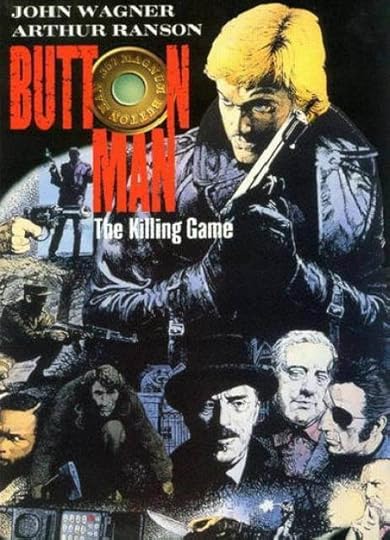 Today I look at John Wagner and Arthur Ranson’s crime thriller series BUTTON MAN.
Today I look at John Wagner and Arthur Ranson’s crime thriller series BUTTON MAN.
BUTTON MAN ran in the UK’s 2000 AD, a magazine mostly known as the cradle of the popular character JUDGE DREDD (a title I still haven’t managed to read yet). It was the Kitchen Sink Press collection of the first series that caught my eye on the shelf in my local comic shop, and particularly Arthur Ranson’s realistic art that arrested my attention. The guy in the upper right corner reminded me of the actor Sean Bean, whom I’d dug as 006 in GOLDENEYE, and the guy with the eyepatch on the bottom looked a bit like Pacino. Plus, the title BUTTON MAN: THE KILLING GAME stuck in my head, and reminded me of something I’d heard rumored as the title for a forthcoming John Woo movie. I was heavy into Woo and Hong Kong bullet ballets or heroic bloodshed movies at the time, having just stumbled across THE KILLER on Cinemax.
With its stark, art, striking inks and colors, and oversized format that harkened back to the Giant Sized Annuals I’d loved so much as a kid, to say nothing of the extremely bloody violence that a cursory flip through convinced me was within, I didn’t resist picking up BUTTON MAN: THE KILLING GAME for very long.
BUTTON MAN man opens brilliantly, in classic noir fashion, with a bleeding man stumbling into a psychiatrist’s office as it’s about to close, and demanding to see the doctor. Despite Dr. Spalding’s assurances that he’s not the right kind of doctor, the wounded man produces a pistol and disagrees. Spalding takes the man into his office and lets him lay down on the patient couch.
“I’ve got this problem, doc,” says the wounded man, who introduces himself as Harry Exton. “I can’t stop killing people. They won’t let me.”
“Who won’t let you?” asks Spalding.
“The voices.”
And then Harry begins his tale.
Harry Exton (or Harry ‘Ex) is a British ex-mercenary, down on his luck, when he bumps into an old military buddy, Carl, who invites him to take part in ‘The Game,’ to make a little ‘dosh.’
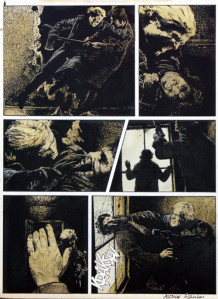 The premise of The Game is that wealthy backers, called ‘Voices’ because they never make direct contact except by telephone, sponsor hired killers, or ‘button men’ (a reference to the button-like appearance of the back end of a bullet) and then pit them against each other in life and death situations, wagering immense sums of money on the outcome. It’s modern day gladiatorial combat, fought in the English countryside, and on the very streets of London. The only rule is that a button man may choose to spare another by taking his marker (cutting off a finger) instead of his life. The third time’s the charm, and a kill is expected after that. Otherwise, it’s don’t get caught, dispose of the bodies discreetly (Harry and Carl dump their bodies with a farmer who turns the corpses into chicken feed), and above all, don’t quit.
The premise of The Game is that wealthy backers, called ‘Voices’ because they never make direct contact except by telephone, sponsor hired killers, or ‘button men’ (a reference to the button-like appearance of the back end of a bullet) and then pit them against each other in life and death situations, wagering immense sums of money on the outcome. It’s modern day gladiatorial combat, fought in the English countryside, and on the very streets of London. The only rule is that a button man may choose to spare another by taking his marker (cutting off a finger) instead of his life. The third time’s the charm, and a kill is expected after that. Otherwise, it’s don’t get caught, dispose of the bodies discreetly (Harry and Carl dump their bodies with a farmer who turns the corpses into chicken feed), and above all, don’t quit.
This is a million dollar concept superbly executed, and I’m really surprised that somebody in Hollywood hasn’t made it yet (it turns out one of my favorite directors, Nicholas Wending Refn, is attached as of this writing to adapt it).
I don’t think there’s a more badass, ruthless anti-hero in all of graphic fiction than Harry ‘Ex. Harry is a very competent killer, a believable professional, entirely practical and without remorse, like the James Bond of the early Fleming novels, but with a calculating, vicious, increasingly (as the series progresses) psychopathic streak even Bond can’t match.
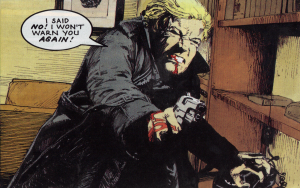 The psychopathy doesn’t necessarily come out in THE KILLING GAME, but at the last Comic Con my dream of finally acquiring the two sequels alluded to in the Kitchen Sink introduction by Arthur Ranson, finally came true. I picked up THE CONFESSION OF HARRY EXTON and KILLER KILLER. It’s fascinating to watch the progression of Harry’s character from THE KILLING GAME on.
The psychopathy doesn’t necessarily come out in THE KILLING GAME, but at the last Comic Con my dream of finally acquiring the two sequels alluded to in the Kitchen Sink introduction by Arthur Ranson, finally came true. I picked up THE CONFESSION OF HARRY EXTON and KILLER KILLER. It’s fascinating to watch the progression of Harry’s character from THE KILLING GAME on.
In KILLING GAME, Harry is a bored predator who enjoys the novelty of the game, and the chance to exercise his old killing muscles, but after he kills a two time loser on a railroad track and the man warns him that the Voices will never let him quit (just before his head is severed by an oncoming express), he begins to rankle. On a whim, he mentions to his ‘Voice’ that he’s thinking about quitting, and the very next Game out he’s set up for the kill, forced to fight alone against a superior number of heavily armed button men, including his friend Carl, with only an eight shot pistol.
Harry still prevails, and when Carl makes it plain he has no intention of killing Harry, somebody kills him instead. With his dying breath, Carl tells Harry something no button man is supposed to know – the name of his Voice.
It only takes one visit to Carl’s Voice with a pair of pliers to learn the name of Harry’s sponsor, Dr. Spalding, to whom he has been relating his story.

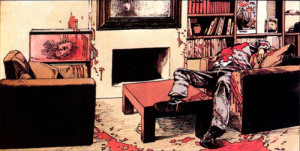 Spalding attempts to poison Harry with some kind of psychotrope, but Harry manages to bring the doctor down with a butcher knife, and leaves his head floating in his office fish tank.
Spalding attempts to poison Harry with some kind of psychotrope, but Harry manages to bring the doctor down with a butcher knife, and leaves his head floating in his office fish tank.
The comic ends with him in the back of a wailing ambulance tearing through the rain-washed London streets at night.
I’ve recommend THE KILLING GAME to everybody I know who’s never read a comic book or is looking for something other than superheroes. It’s a perfectly realistic and clever thriller in the mode of a good 1970’s British crime movie like THE LONG GOOD FRIDAY or GET CARTER, a kick ass, adult crime movie rendered in two dimensions.
So it took about eighteen years for me to finally get a hold of the sequels, and about an hour and a half to tear through both of them.
THE CONFESSIONS OF HARRY EXTON picks up with Harry being wheeled into the hospital, poisoned and suffering from multiple gunshot wounds. He’s put under guard, a known killer, but the police officers assigned to guard him are promptly knocked out by a nurse and a doctor, who sedate Harry and spirit him from the hospital.
Harry awakens in a nice house in upstate New York, with a beautiful redheaded wife, Cora, and a proposition from a blustery downhome United States senator, Jackson. Stay in America with Cora and a new identity, and play the American league of the Game for the senator, where the stakes and rewards are even higher.
Harry agrees, but he’s a changed man from THE KILLING GAME. Maybe it was the death of Carl, but somewhere along the way, Harry’s burned out. He’s lost his heart, his humanity. He’s not out for markers anymore, and though he swiftly rises in the American rankings, he kills just about every button man he goes up against, sometimes even after his opponent is down and out.
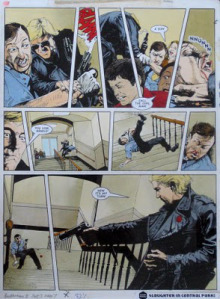 In one memorable sequence, Harry is given a red carnation and an assortment of silent weapons and told to play the game during open hours of the New York Museum Of Natural History. His opponent (also wearing a red carnation, to mark him as such), turns out to be the mousy looking on duty security guard. When the conflict escalates past the clandestine stage, and carries out into a full tilt running shootout in Central Park, Harry executes the man at the Alice In Wonderland statue, and heads off for the Cayman Islands with Cora, as cold and unconcerned as if he’d just stepped on a cockroach.
In one memorable sequence, Harry is given a red carnation and an assortment of silent weapons and told to play the game during open hours of the New York Museum Of Natural History. His opponent (also wearing a red carnation, to mark him as such), turns out to be the mousy looking on duty security guard. When the conflict escalates past the clandestine stage, and carries out into a full tilt running shootout in Central Park, Harry executes the man at the Alice In Wonderland statue, and heads off for the Cayman Islands with Cora, as cold and unconcerned as if he’d just stepped on a cockroach.
Harry’s ruthlessness and willingness to kill good button men starts to upset the Voices, and he is urged by the senator through Cora to ease up. But telling Harry to do anything is the beginning of the end for anybody.
Cora attempts to reign Harry in, but he’s already figured out she’s doing a job, and finds the last sap Cora leashed frozen beneath the surface of the pond out back of his house. Cora’s a tool, but she’s careful and has insurance, hidden camera footage of the Game implicating the Senator.
Harry takes the evidence straight to the senator’s Louisiana compound and cuts his way through a small army of guards and button men, all to prove his point – he wants out. And he gets it.
Or so he thinks.
KILLER KILLER kicks the Button Man concept into high gear.
Harry’s now living off his winnings in a lone cabin deep in rural Montana under an assumed name. He goes hunting in the mountains with a Vietnam vet, pursues an adulterous relationship with the local dentist’s wife, and basically takes care of his dog and does a lot of home improvement (albeit always with a pistol or a rifle in reach). When he hears a radio report about the accidental death of Senator Jacklin, his old Voice, he erases Cora’s VHS tapes and thinks he’s at last done with the Game. His biggest worry is his girlfriend Grace, who swears her husband Dennis knows about them.
After a trip to see said Dennis, Harry’s life starts to get deadly interesting again. He spies a couple out of towners at the local diner with missing ‘markers’ and the next night is attacked at his house by gunmen and chased into the woods. But the pursuers leave off running him down, and drive off.
He receives a telephone call from a Voice, who explains to him that now that the Senator is dead, he is once again, fair game. The Voice appreciates his skill and offers to take him on as a button man. When Harry refuses, the Voice urges him to run. There are thirteen killers on his trail and they will begin coming for him at 0500.
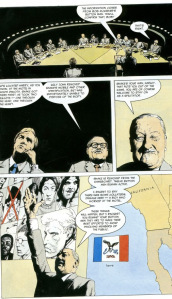 The Voice is a wealthy movie producer, Frankie, making a fictional film about the Game entitled Killer Killer, about which a lot of buzz is being generated, both in Hollywood and with his fellow Voices, who are not keen on the idea. Frankie has gathered the other Voices together for a unique event, a nationwide hunt for Harry, winner take all. They monitor Harry’s flight via GPS on a big board in a room that hearkens to the war room from Dr. Strangelove and was one of Frankie’s old sets.
The Voice is a wealthy movie producer, Frankie, making a fictional film about the Game entitled Killer Killer, about which a lot of buzz is being generated, both in Hollywood and with his fellow Voices, who are not keen on the idea. Frankie has gathered the other Voices together for a unique event, a nationwide hunt for Harry, winner take all. They monitor Harry’s flight via GPS on a big board in a room that hearkens to the war room from Dr. Strangelove and was one of Frankie’s old sets.
Harry runs from city to town, altering his identity and appearance, ditching vehicles, only to have a button man show up wherever he goes.
This outing is the most expertly plotted since the original BUTTON MAN, and my second favorite of the three titles. Again, I’m amazed this isn’t already a movie. Harry figures out Frankie’s identity after hearing and seeing him give an interview on some Access Hollywood type show, setting the stage for their ultimate confrontation.
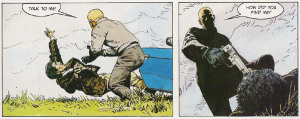 But first Harry has to figure out how the hell he’s being tracked cross country, a plot point that seemed kinda obvious to me, though well played out.
But first Harry has to figure out how the hell he’s being tracked cross country, a plot point that seemed kinda obvious to me, though well played out.
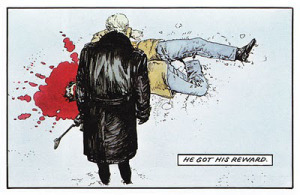 This is Harry at his least likable, most cold blooded. He is far from the man he was in KILLING GAME, executing more than a few crippled button men, and a mother turned button (wo)man (“Please Harry,” she pleads, holding up a photo of her children, “remember my kids.” “How could I forget them? I’m the one who was going to put them through college,” Harry responds, before blowing her away), inadvertently causing the death of his friend, blasting an unarmed guy at a stop light, and murdering a guy he cuts a deal with in front of his young niece in the name of tying up loose ends.
This is Harry at his least likable, most cold blooded. He is far from the man he was in KILLING GAME, executing more than a few crippled button men, and a mother turned button (wo)man (“Please Harry,” she pleads, holding up a photo of her children, “remember my kids.” “How could I forget them? I’m the one who was going to put them through college,” Harry responds, before blowing her away), inadvertently causing the death of his friend, blasting an unarmed guy at a stop light, and murdering a guy he cuts a deal with in front of his young niece in the name of tying up loose ends.
Not to say Harry isn’t justified in his killings, though perhaps not in the one on the last page, but Harry is pure, cold blooded killer by the end of KILLER KILLER.
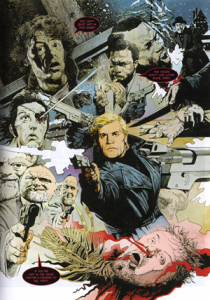 I recommend this series without reservation. It’s one of the coolest comics I’ve read in a long time and is consistently great from trade to trade. There is a fourth book, HITMAN’S DAUGHTER, which I couldn’t bring myself to pick up at the time as it didn’t have Arthur Ranson’s pencils, but I now feel compelled to go and scoop it up as well. Maybe I’ll add to this review when I do, or give it its own page.
I recommend this series without reservation. It’s one of the coolest comics I’ve read in a long time and is consistently great from trade to trade. There is a fourth book, HITMAN’S DAUGHTER, which I couldn’t bring myself to pick up at the time as it didn’t have Arthur Ranson’s pencils, but I now feel compelled to go and scoop it up as well. Maybe I’ll add to this review when I do, or give it its own page.
There’s also a book called GET HARRY EX. I can’t figure out where that one fits in continuity, or if it’s a renamed collection or something, but THE KILLING GAME, CONFESSIONS OF HARRY EXTON, and KILLER KILLER are all available now from 2000 AD in nice new trades on Amazon.
Get ‘em!
Hasta pronto.


July 21, 2013
Comic-Con 101: The Difference Between Protesters And Proselytizers
So I just got back from an excellent Comic Con, probably the best one yet.
But something’s bugging me.
Every year I go, I see the young Christian people standing on the corner with their personal PA systems and picket signs with biblical quotes and slogans like GOD IS LOVE. Every once in a while there’s an older guy with a bullhorn saying something stupid. This year there was a guy scolding the passersby for glorifying the serial killer character Dexter, whom he described as “a killer of little girls.”
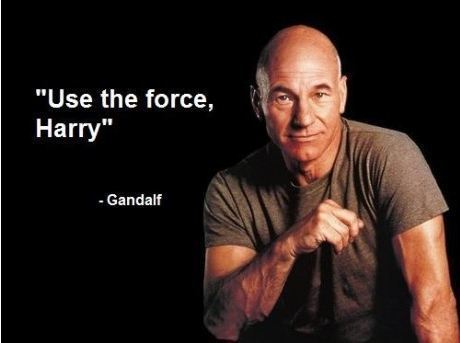 Obviously he hasn’t ever seen an episode of DEXTER. My buddy Ryan made this observation as we were passing him on the way into the convention center, and yeah, that’s kind of a dumb thing to say. If nerds are anything, they’re sticklers for facts. If you want to stop up a geek’s ears quick, display a lack of knowledge about one of their beloved properties in the midst of criticizing it.
Obviously he hasn’t ever seen an episode of DEXTER. My buddy Ryan made this observation as we were passing him on the way into the convention center, and yeah, that’s kind of a dumb thing to say. If nerds are anything, they’re sticklers for facts. If you want to stop up a geek’s ears quick, display a lack of knowledge about one of their beloved properties in the midst of criticizing it.
But that’s not really what I wanna touch upon today. That guy was the exception to most of the proselytizers I saw.
Most of them, as I said, were younger people with innocuous Bible quotes on their signs about love and redemption and the like, and whenever the trolley started to cross and they had a captive audience, they’d launch into a calm, measured, pre-memorized speech about God’s love and Jesus’ acceptance, etc.
Nobody really confronts them or engages them aside, and they don’t really address anyone in particular either. As a matter of fact, it’s like they’re not there.
Yet without fail, every single time I crossed the street, as soon as we were out of reach, I would hear some costumed crusader or video game character nearby begin railing against them, loudly cracking wise on their beliefs, or “cleverly” tying Jesus or God into some comic book or pop culture reference (“Didn’t anybody tell you? Zombies are out, dude!” one cut up shouted at a kid with a JESUS IS LIFE sign in passing).
There is a general misconception among con-goers that A) these Christians are representatives of the Westboro Baptist Church and that B) they are protesting the Con.
There are protesters there, yes (like the Dexter-hater I mentioned – though really, although uninformed, he probably is right about the dubious merit of idolizing/idealizing a serial killer), but they are very, very few in number. I only heard one this year.
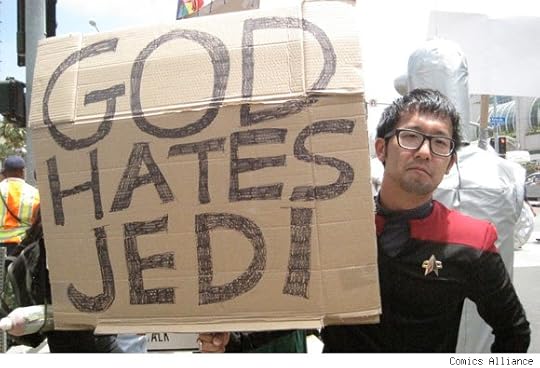
Cool
The Westboro Baptist Church are never at Comic Con. The people there post 2010 have no affiliation with that organization/sect. I was at the con in 2010 during that big, much reported protest and while I do remember the huge and hilarious (GOD HATES JEDI declared a Starfleet officer’s sign) anti-protest, I don’t remember even seeing a WBC representative there. Maybe they were. Don’t know.
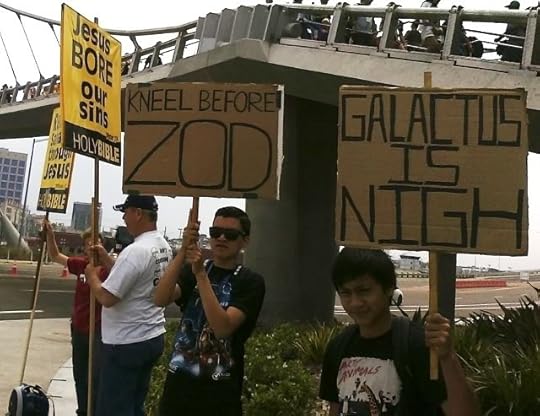
Uncool
I do know I started noticing the Christians with signs in subsequent years. But none of their signs read GOD HATES FAGS or the like. Uniformly they are inoffensive bible passages touting love and salvation, or simple affirmations of faith. It’s possible these people were at the Con before 2010 and I just don’t remember seeing them.
I’ve also noticed the clever counter-protesters out every year since 2010 as well, the signs changing to fit into the latest pop culture fad. KNEEL BEFORE ZOD was a new one this go round.
But the point of all this is, the Con goers are no longer counter protesting. They’re the protesters, and they are in force, and far outnumber the picketers. I’ve kind’ve been appalled at the vitriolic, decidedly un-Jedi stuff I’ve heard people say to and about these Christians.
Guys, they are not protesters condemning you for your spandex or love of She Hulk. They are proselytizers, or street preachers, just trying to spread the message of their faith. You don’t have to listen to them, just like you don’t have to take the ENDER’S GAME handbills the hot chicks in skimpy outfits push at you. If you have a message you want to spread, why would you not place yourself at the busiest intersection on the busiest attendance day of the year, when thousands of strangers are passing by? The club owners are doing it. The webseries filmmakers are doing it.
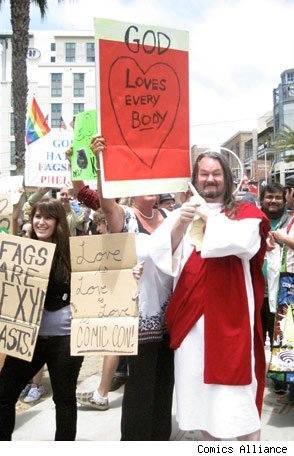
Probably the best picket sign I’ve ever seen
What’s the problem? Why are so many swaggering geeks who can laughingly quote the most un-PC lines of Tarantino aloud word for word in ear shot of little children in Robin and Princess Bubblegum costumes so bent out of shape by the word Jesus?
The Westboro Baptist Church sucks, and the counter protest was awesome. But it’s over, folks. Lighten up. Don’t be douchebags to people with the passion to stand out on a corner in high temp and full sun for hours on end to spread the word of the motivating factor of their lives. It’s the same kind of passion that causes you to band together with your fellow fans to sweat under the nearly unbearable heat of a wookiee costume or full battle armor for hours on end.
So…a little common courtesy, fellow fanboys. A little respect. A little less passion and a little more compassion. Don’t be a bully.
Carry on, and may the Force be with you.


July 8, 2013
The Lone Ranger And Tonto Fistfight The Critics
I’ve been against this new Lone Ranger movie since it was announced Johnny Depp was playing Tonto. You can read my initial reaction, and my personal take on the character HERE.
 I had no intention of seeing this thing, but about a month ago, I accidentally committed what’s pretty much a hanging offense in terms of movie appreciation: I spoiled the ending of a movie (STAR TREK: INTO DARKNESS) to a friend who had been looking forward to the thing all year, the very day before he was headed to the theater. It was an honest mistake (I thought he had seen it early, he sees a lot of movies early, and that we were talking about WRATH OF KHAN), but yeah, I felt pretty terrible, particularly as it was a movie I had no intention of seeing (I had read the synopsis). I told him I owed him, that he could name any fitting recompense. Knowing full well my resistance to the thing on a moral basis, he told me I had to go see THE LONE RANGER and talk about it with him on his podcast.
I had no intention of seeing this thing, but about a month ago, I accidentally committed what’s pretty much a hanging offense in terms of movie appreciation: I spoiled the ending of a movie (STAR TREK: INTO DARKNESS) to a friend who had been looking forward to the thing all year, the very day before he was headed to the theater. It was an honest mistake (I thought he had seen it early, he sees a lot of movies early, and that we were talking about WRATH OF KHAN), but yeah, I felt pretty terrible, particularly as it was a movie I had no intention of seeing (I had read the synopsis). I told him I owed him, that he could name any fitting recompense. Knowing full well my resistance to the thing on a moral basis, he told me I had to go see THE LONE RANGER and talk about it with him on his podcast.
Sigh.
So I went into this thing with my arms firmly crossed, and I saw it in a theater I hate (because it was cheaper and closer).
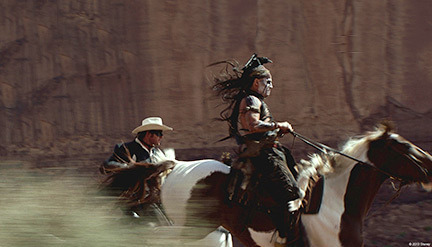 But you know, I came away appreciating it. It touched the greatness of the original material at times, and everybody did a fine job. I was a fan of the movie REMO WILLIAMS as a kid, and having seen it on a crummy, blurry VHS tape with tracking lines galore, I didn’t figure out the Korean character Chiun was played by Joel Gray, a white guy, until maybe seven years ago. I still think he did a pretty bang up job, and Depp plays Tonto well and fine here. I still wonder about his Native ancestry and maintain somebody like Adam Beach or an unknown Native actor would’ve been more ideal in the part, but whatever. For the purposes of this piece, I’m gonna refer you to my previous blog post and ignore all that. For now, this’ll take its place alongside REMO WILLIAMS and GUNGA DIN, in terms of white characters in makeup that I grudgingly accept due to my enjoyment of the material.
But you know, I came away appreciating it. It touched the greatness of the original material at times, and everybody did a fine job. I was a fan of the movie REMO WILLIAMS as a kid, and having seen it on a crummy, blurry VHS tape with tracking lines galore, I didn’t figure out the Korean character Chiun was played by Joel Gray, a white guy, until maybe seven years ago. I still think he did a pretty bang up job, and Depp plays Tonto well and fine here. I still wonder about his Native ancestry and maintain somebody like Adam Beach or an unknown Native actor would’ve been more ideal in the part, but whatever. For the purposes of this piece, I’m gonna refer you to my previous blog post and ignore all that. For now, this’ll take its place alongside REMO WILLIAMS and GUNGA DIN, in terms of white characters in makeup that I grudgingly accept due to my enjoyment of the material.
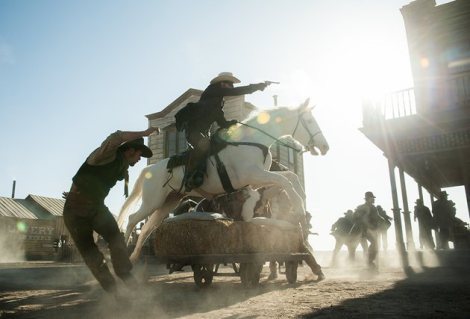 The Lone Ranger is fun. It’s like SILVERADO. A high adventure, rip snorting bombastic shoot ‘em up where the bullets are as fast and plentiful as the jokes. It’s a buckskin buddy movie.
The Lone Ranger is fun. It’s like SILVERADO. A high adventure, rip snorting bombastic shoot ‘em up where the bullets are as fast and plentiful as the jokes. It’s a buckskin buddy movie.
It’s LOADED with inaccuracies, as I’ve read in criticisms all over the place. It’s 1869, but there’s cartridge ammunition flying all over the place (most guns were cap and ball black powder till the mid 1870′s), and the Texas Rangers go thundering past the distinctive mesas of Monument Valley, wayyy out of their jurisdiction. The Comanches range far out of their usual stomping grounds as well (and Tonto was a Pottawatomie anyway).
But consider this. Verbinski and company aren’t dummies. They displayed a love for pirate movies in the first PIRATES OF THE CARIBBEAN, referencing everything from THE CRIMSON PIRATE to CAPTAIN BLOOD. The same thing happens here. THE LONE RANGER is full of homages to classic westerns. Tonto’s elderly makeup reminded me a lot of LITTLE BIG MAN from the get-go, and ONCE UPON A TIME IN THE WEST is referenced a few times, in the train sequences, and in the musical cues throughout.
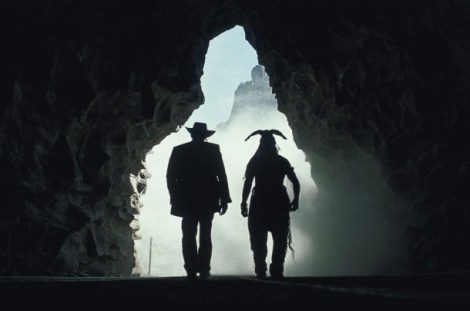
The Searchers inspired?
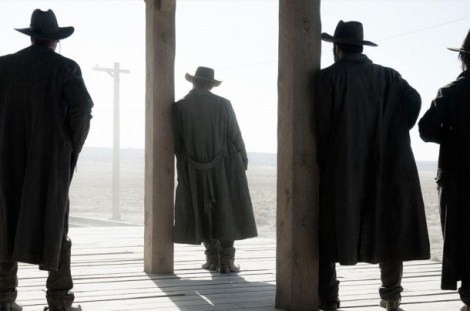
Cue the Morricone.
Maybe I’m giving the production team a little too much credit, but is it possible these glaring inaccuracies were intentional? John Ford regularly told us Monument Valley was in Texas, and Leone had Tuco, Angel Eyes, and Blondie loading their revolvers with cartridge ammo in the midst of the Civil War. Heck, maybe even Johnny Depp as Tonto is a reference to all the white guys in redface that permeated THE SEARCHERS, WINCHESTER 73, and numerous other classic outings.
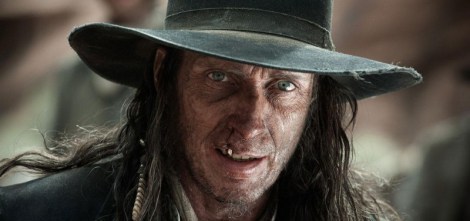 And let me say, the ubiquitous William Fichtner, whose face I was amazed to see when I looked the actor up after the movie, as you see this guy in solid supporting roles everywhere, played the HELL out of villain Butch Cavendish. There’s a scene where he escapes from a prison train. The doors to the car open behind him to show his gang racing along side the train, and he steps out onto the saddle. For an instant he has this fantastically exultant grin, that was a spectacular choice. Wish I had a freeze frame of it, because he’s got this sense of rogueish evil relish that really made me dig the portrayal.
And let me say, the ubiquitous William Fichtner, whose face I was amazed to see when I looked the actor up after the movie, as you see this guy in solid supporting roles everywhere, played the HELL out of villain Butch Cavendish. There’s a scene where he escapes from a prison train. The doors to the car open behind him to show his gang racing along side the train, and he steps out onto the saddle. For an instant he has this fantastically exultant grin, that was a spectacular choice. Wish I had a freeze frame of it, because he’s got this sense of rogueish evil relish that really made me dig the portrayal.
My biggest criticism about the movie is that Armie Hammer isn’t really allowed to BE the Ranger as we know him until the last twenty minutes. Up until then he’s as bumbling as his cinematic grand nephew Seth Rogen (as Britt Reid in THE GREEN HORNET – interestingly, Tom Wilkinson, who plays the rail baron in THE LONE RANGER, played James Reid in THE GREEN HORNET). Is there some PC fear on the part of Disney to let the Ranger surpass Tonto? I don’t know. What I do know is this movie’s getting the John Carter treatment. Like that movie, it’s much better than people are being led to believe, and it doesn’t deserve to bomb the way something crummy as say, THE WATCH, does. It’s not perfect. But it’s escapist western adventure. A fine fantasy.
But those last twenty minutes are sublime. Yes it’s completely unbelievable to have Silver racing along the top of a speeding train (or IN it), but when Hammer is trading shots with Barry Pepper (on ANOTHER train) and the William Tell Overture is blaring….
Go see him before he rides off into the sunset for another twenty years.


July 4, 2013
DT Moviehouse Review: The Blood Of Heroes
Time once more for my blog feature, DT Moviehouse Reviews, in which I make my way alphabetically through my 200+ DVD/Blu-Ray collection (you can see the list right here) and decide if each one was worth the money. Today I review the post apocalyptic sports movie The Blood Of Heroes.
(1989) Written and Directed by David Webb Peoples
Tagline:
The time will come when winning is everything.
What It’s About:
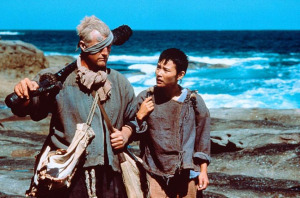 In a bleak post apocalyptic future, scarred and battered juggers in piecemeal armor and gear roam the wastelands from settlement to settlement playing The Game, a furious cross between football and gladiatorial combat, where the object is to place a dog skull on a spike before three hundred stones hit a makeshift gong. When ex-League jugger Sallow (Rutger Hauer) and his team take on a new, ambitious young player named Kidda (Joan Chen), they decide to take their game as far as it can go – to the vicious League play deep beneath the ground in the subterranean Red City. But Sallow’s own past mistakes may stand in the way of all their aspirations.
In a bleak post apocalyptic future, scarred and battered juggers in piecemeal armor and gear roam the wastelands from settlement to settlement playing The Game, a furious cross between football and gladiatorial combat, where the object is to place a dog skull on a spike before three hundred stones hit a makeshift gong. When ex-League jugger Sallow (Rutger Hauer) and his team take on a new, ambitious young player named Kidda (Joan Chen), they decide to take their game as far as it can go – to the vicious League play deep beneath the ground in the subterranean Red City. But Sallow’s own past mistakes may stand in the way of all their aspirations.
Why I Bought It:
I saw this one on Cinemax one night and expected absolutely nothing, but I liked Rutger Hauer in Blade Runner, Blind Fury, and Ladyhawke, and I’ll give any post apocalyptic movie at least five minutes of my time.
A lot of these dystopian future movies open up with a paragraph describing at length how the world got in the mess it’s in. The Blood of Heroes opens with -
People no longer remembered the Golden Age of the 20th Century. They didn’t remember the miraculous technology or the cruel wars that followed. They didn’t remember when juggers first played The Game or how it came to be played with a dog skull….
And that’s it.
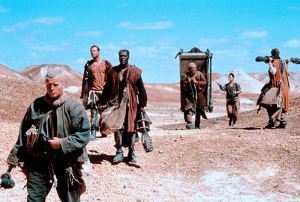 By this brilliantly concise bit of flavor text, we learn all we need to going in, and by the richness of the world that follows, we discover all we need to.
By this brilliantly concise bit of flavor text, we learn all we need to going in, and by the richness of the world that follows, we discover all we need to.
The first scene is of Sallow leading his team out of the desert to challenge the village team, with the coach/medic/trainer Gandhi MacIntyre bringing up the rear, lugging their equipment in a wardrobe strapped to his back. We see the juggers gear up, their armor culled from scavenged materials like old tire treads and the like.
 Then The Game begins, and if we’re paying attention, we can pretty much figure it out. The village idiot (and it seems in every Game we see played, it’s ALWAYS the village idiot who gets the stone counting job – maybe because they’re the only ones who don’t get distracted by the game) pitches rocks at a bit of hanging metal and announces when he’s reached one hundred, which means a cessation of play. The big guys in armor go at it, alternately trying to protect their own or harm the other team’s kwik, the lightly armored and unarmed one whose job it is to spear the dog skull on the other side’s stake. This is the equivalent of catching the Golden Snitch in Harry Potter. It ends the game. I wonder if JK Rowling has seen The Blood Of Heroes actually, because the big guys are like beaters. The only guy for which there is no Quidditch counterpart is the slash, who protects the kwik with a whirling chain.
Then The Game begins, and if we’re paying attention, we can pretty much figure it out. The village idiot (and it seems in every Game we see played, it’s ALWAYS the village idiot who gets the stone counting job – maybe because they’re the only ones who don’t get distracted by the game) pitches rocks at a bit of hanging metal and announces when he’s reached one hundred, which means a cessation of play. The big guys in armor go at it, alternately trying to protect their own or harm the other team’s kwik, the lightly armored and unarmed one whose job it is to spear the dog skull on the other side’s stake. This is the equivalent of catching the Golden Snitch in Harry Potter. It ends the game. I wonder if JK Rowling has seen The Blood Of Heroes actually, because the big guys are like beaters. The only guy for which there is no Quidditch counterpart is the slash, who protects the kwik with a whirling chain.
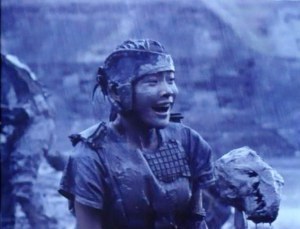 Perhaps The Game has taken the place of raiding and warfare, because the winning team automatically gets their pick of young villagers (male and female) to sleep with, is treated to a no hard feelings banquet by the losing team, and is then paid tribute by every villager from the youngest to the eldest. Then the next morning the winning juggers set out with the defeated village’s dog skull. On to the next match.
Perhaps The Game has taken the place of raiding and warfare, because the winning team automatically gets their pick of young villagers (male and female) to sleep with, is treated to a no hard feelings banquet by the losing team, and is then paid tribute by every villager from the youngest to the eldest. Then the next morning the winning juggers set out with the defeated village’s dog skull. On to the next match.
 The excellence of this weird little movie, which is much better than it should be, is in its details. The juggers get the crap beat out of them. Joan Chen bites a guy’s ear off, and in another match, Rutger Hauer has his eye knocked out. The rest of the guys, especially Delroy Lindo’s Mbulu and Anna Katarina’s Big Cimber, are crisscrossed with old scars and cauliflower ears. Justin Monjo’s Dog-Boy looks like his entire face has been removed and put back on upside down. This is a violent as hell sport with little protection, in a world where doctoring is a lost art. Instead of a lot of pretty boys and girls, the bodies of the characters and their appearances reflect this admirably. Even Joan Chen, God bless her for taking on this part, gets a bike chain or dog leash or something across the cheek early on, and Sallow’s old League buddy Gonzo (Max Fairchild, who, along with Hugh Keyes Byrnes, appeared in the granddaddy of savage post apocalyptic movies, Mad Max) looks like Frankenstein’s monster, with an exposed steel plate in the side of his head. Fittingly, only Byrnes’ Lord Vile and the rest of the underground dwelling elite are for the most part unscarred, though they’re uniformly pale and unseemly looking.
The excellence of this weird little movie, which is much better than it should be, is in its details. The juggers get the crap beat out of them. Joan Chen bites a guy’s ear off, and in another match, Rutger Hauer has his eye knocked out. The rest of the guys, especially Delroy Lindo’s Mbulu and Anna Katarina’s Big Cimber, are crisscrossed with old scars and cauliflower ears. Justin Monjo’s Dog-Boy looks like his entire face has been removed and put back on upside down. This is a violent as hell sport with little protection, in a world where doctoring is a lost art. Instead of a lot of pretty boys and girls, the bodies of the characters and their appearances reflect this admirably. Even Joan Chen, God bless her for taking on this part, gets a bike chain or dog leash or something across the cheek early on, and Sallow’s old League buddy Gonzo (Max Fairchild, who, along with Hugh Keyes Byrnes, appeared in the granddaddy of savage post apocalyptic movies, Mad Max) looks like Frankenstein’s monster, with an exposed steel plate in the side of his head. Fittingly, only Byrnes’ Lord Vile and the rest of the underground dwelling elite are for the most part unscarred, though they’re uniformly pale and unseemly looking.
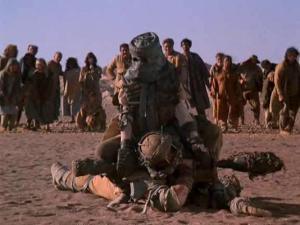 This looks like a low budget production, but the set design and art direction are inspired. They really made a believable world here, going the ‘this is so strange it has to be true’ kind of approach. At a banquet in the Red City, diners pick the flesh from a cooked Komodo Dragon at a buffet. Getting into the Red City requires paying the elevator guards in nuts and bolts (gleaned from villages whose teams the juggers have bested), and then making an inordinately long descent, that appears to last for hours, possibly a day. What is the Red City? The remains of an underground plant? A vast bomb shelter? A little of both? The city inn has open air sleeping platforms clinging to the side of a stone wall and you have to reach your rented platform by climbing ladders and inching along precarious ledges, passing huddled families, lovemaking couples, and basically the whole strata of humanity along the way. The aforementioned idiot stone counter/pitcher, always has his three piles of a hundred stones each carefully laid out for him (that makes me laugh – does he get there early and do it himself, or do they not even trust him to do that?).
This looks like a low budget production, but the set design and art direction are inspired. They really made a believable world here, going the ‘this is so strange it has to be true’ kind of approach. At a banquet in the Red City, diners pick the flesh from a cooked Komodo Dragon at a buffet. Getting into the Red City requires paying the elevator guards in nuts and bolts (gleaned from villages whose teams the juggers have bested), and then making an inordinately long descent, that appears to last for hours, possibly a day. What is the Red City? The remains of an underground plant? A vast bomb shelter? A little of both? The city inn has open air sleeping platforms clinging to the side of a stone wall and you have to reach your rented platform by climbing ladders and inching along precarious ledges, passing huddled families, lovemaking couples, and basically the whole strata of humanity along the way. The aforementioned idiot stone counter/pitcher, always has his three piles of a hundred stones each carefully laid out for him (that makes me laugh – does he get there early and do it himself, or do they not even trust him to do that?).
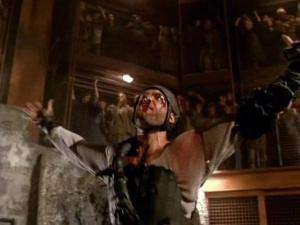 The cast is fantastic. You’re getting some brilliant actors early in their careers, particularly Lindo and Vincent D’onofrio, who plays Young Gar, the exuberant, hotheaded slash. But everybody does a great job, and the movie is interspersed with some fine character moments. Gandhi orders six meat pies from a vendor, but has to keep changing his order as first Sallow and then Kidda decide to check something else out. When the six pies arrive he complains that there must be some mistake, he only ordered four. The kwik Kidda replaces, Dog-Boy, has a cool scene where he gruffly announces his leg injury is too severe, and demands to be left his share of food and water in the desert. When the team makes their official challenge to the city League and the wizened old authenticators pass their bag of captured dog skulls back and forth, inspecting them and the juggers one by one, Gar, exasperated by the waiting and wanting to make an impression, begins twirling his chains and roaring until a disapproving look from the old men makes him stop and clear his throat.
The cast is fantastic. You’re getting some brilliant actors early in their careers, particularly Lindo and Vincent D’onofrio, who plays Young Gar, the exuberant, hotheaded slash. But everybody does a great job, and the movie is interspersed with some fine character moments. Gandhi orders six meat pies from a vendor, but has to keep changing his order as first Sallow and then Kidda decide to check something else out. When the six pies arrive he complains that there must be some mistake, he only ordered four. The kwik Kidda replaces, Dog-Boy, has a cool scene where he gruffly announces his leg injury is too severe, and demands to be left his share of food and water in the desert. When the team makes their official challenge to the city League and the wizened old authenticators pass their bag of captured dog skulls back and forth, inspecting them and the juggers one by one, Gar, exasperated by the waiting and wanting to make an impression, begins twirling his chains and roaring until a disapproving look from the old men makes him stop and clear his throat.
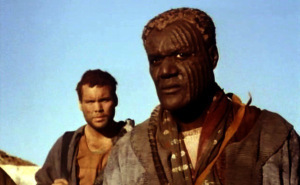 There’s more to just the up and coming rookie sports story to Blood Of Heroes as well. There’s a nicely understated subplot about Sallow having left the league because of his affair with a rich man’s woman, and Lord Vile appears to be that rich man as he recognizes Sallow and orders Gonzo to blind him and break his legs in the challenge match (something Gonzo admirably refuses to do), but the woman he’s with seems a little too young to be the one in question. I also like her assertion that she wants to see the blood of heroes, not plain butchery and brutality, and how at the end, when the match is over and the credits are rolling, she approaches Gar and dips her finger in his blood, running it down her own cheek (and I think, sneaking a taste of it).
There’s more to just the up and coming rookie sports story to Blood Of Heroes as well. There’s a nicely understated subplot about Sallow having left the league because of his affair with a rich man’s woman, and Lord Vile appears to be that rich man as he recognizes Sallow and orders Gonzo to blind him and break his legs in the challenge match (something Gonzo admirably refuses to do), but the woman he’s with seems a little too young to be the one in question. I also like her assertion that she wants to see the blood of heroes, not plain butchery and brutality, and how at the end, when the match is over and the credits are rolling, she approaches Gar and dips her finger in his blood, running it down her own cheek (and I think, sneaking a taste of it).
What is great about this movie is that much is left to be inferred, and yet there’s enough interesting material there to make you wonder about the characters and the world. A fine early effort from the writer of Unforgiven.
I like the score by Todd Boekelheide too. It’s instantly recognizable.
Best Dialogue/Line:
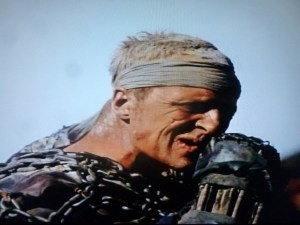 Sallow, upon finding Kidda and Young Gar in bed after a match, groaning more from the pain of their wounds than from pleasure, observes;
Sallow, upon finding Kidda and Young Gar in bed after a match, groaning more from the pain of their wounds than from pleasure, observes;
“Two Juggers can’t fuck after the game. It doesn’t work. Unless you like to rub wounds against wounds.”
Best Scene:
After lasting an unprecedented one hundred stones with the League team (the last record is said to be twenty six), Sallow having been pinned by Gonzo to protect him during the entire first round, and Big Cimber having had her leg broken, Gandhi steps in in the second round as a substitute and hooks and pins the jugger that immobilized Sallow. Sallow dukes it out with Gonzo and defeats him, and Gar and Mbulu defeat their counterparts. Sallow sees Lord Vile watching and goes over to where Kidda is wrestling with her opposite number. Sallow lays the enemy kwik out almost offhandedly, and when Kidda jumps up with the dog skull to score, he puts a hand on her shoulder and tells her;
“Walk…slowly.”
As Sallow’s guys sit on the enemy team, Kidda strolls deliberately across the playing field to the stake, looking up at the cheering onlookers, basking in the moment. It’s the equivalent of Babe Ruth calling his home run when she neatly sets the skull on the stake.
Would I Buy It Again? Yes, it’s the proverbial overlooked gem.
Next In The Queue: Bonnie and Clyde


July 3, 2013
Willow Anne’s Water Damage Giveaway
This is my daughter Willow. She’s three years old.
A couple of days ago I loaded a box of my books into the back of the old Star Destroyer, on the floor between the car seats of her and her brother, Augustus.
Later, when I went to unload the books I found Willie (I call her Willie, after Kate Capshaw’s character in Indiana Jones and the Temple of Doom – don’t tell her mother), I found the top layer of books were wet. Willow had tipped an open water bottle over them.
“Sorry, daddy,” she said.
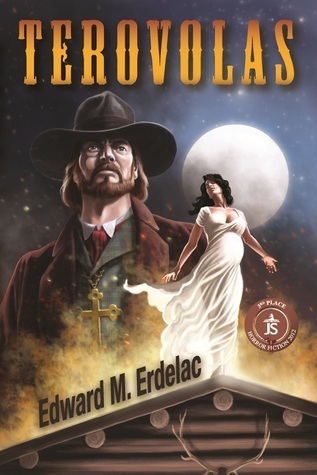 Well, so the end result is, I have three copies of my prize winning Van Helsing in Texas novel TEROVOLAS (read all about that right here and here) and two copies of MERKABAH RIDER: TALES OF A HIGH PLANES DRIFTER, the first book in my four book weird western series about a Hasidic gunslinger tracking the renegade teacher who betrayed his mystic Jewish order of astral travelers to the Lovecraftian Outer Gods (read about that here)….that are basically unsellable. The water damage isn’t extensive, particularly to the Merkabah Riders – just some wrinkling to the back pages. The TEROVOLAS (es) took the brunt, though most of the damage is to the lower ends of the pages and not entirely all the way through the book. None of the pages are stuck together or torn, and there’s no real bleeding.
Well, so the end result is, I have three copies of my prize winning Van Helsing in Texas novel TEROVOLAS (read all about that right here and here) and two copies of MERKABAH RIDER: TALES OF A HIGH PLANES DRIFTER, the first book in my four book weird western series about a Hasidic gunslinger tracking the renegade teacher who betrayed his mystic Jewish order of astral travelers to the Lovecraftian Outer Gods (read about that here)….that are basically unsellable. The water damage isn’t extensive, particularly to the Merkabah Riders – just some wrinkling to the back pages. The TEROVOLAS (es) took the brunt, though most of the damage is to the lower ends of the pages and not entirely all the way through the book. None of the pages are stuck together or torn, and there’s no real bleeding.
At any rate, I can’t in good conscience sell them or donate them to the library, so if anybody’s interested and doesn’t mind a little personality to their books, send an email to emerdelacATgmail.com with your preference of title, name and address.
First five responders, I’ll ship them for free, signed if you like.
UPDATE: Wow, what a great response! Thanks all, for requesting copies. The water-touched copies are gone now, but if you’ve come late to the party and have an e-reader, let me know and I’ll relinquish free e-copies of either book to all respondents who want one till say, 4PM my time (Pacific US). - EME


June 30, 2013
An Excerpt From Coyote’s Trail From Comet Press
July 1st marked the debut of my seventh novel, COYOTE’S TRAIL, from the folks at Comet Press, who previously published my feudal Japanese zombie novella NIGHT OF THE JIKININKI in DEADCORE (read about that one here) .
You can pick it up on Amazon right here - http://www.amazon.com/Coyotes-Trail-E...
Or from the publisher at - http://www.cometpress.us/books/coyote...
It is 1886. Geronimo and his followers, the last Apache resistance to white encroachment, have been transported east, and the blue wool defenders of The Fort settle into boredom, directing their cruel attentions to illicit liquor and prostitutes, their clearest enemy a weak officer’s bullheaded wife on a moral crusade.
One broken and battered Chiricahua boy, Na-e-te-nay, drags himself across the Arizona desert, held together only by a bleak vision of revenge; a vision that will cause him to abandon his warrior traditions and set his feet on Coyote’s Trail — the road of murder and evil.
After a brothel shootout between Na-e-te-nay and the US cavalry ends in fire and death, America, a broken young Mexican woman with her own reasons for hating the cavalry, finds herself pulled into his plot.
Enlisting the nominal aid of Rogerio, a shiftless, sadistic whiskey peddler who knows more about America’s hellish past than even she does, the three conspire to draw Na-e-te-nay’s remaining enemies out of the safety of The Fort, using America’s body as bait.
But America has her own vision of revenge…
COYOTE’S TRAIL is one of the bleakest, most violent stories I’ve ever written. The basic premise is that a vengeful Chiricahua Apache kid uses a Mexican prostitute to lure out his enemies and then murders them in flagrante delicto (‘in blazing offense’ or, in the collquial usage, in the midst of sex). It stems from my fascination in deviant outcast stories like the works of Paul Schraeder and Jim Thompson, and I’d cite the westerns of Forrest Carter (particularly LOOK FOR ME ON THE MOUNTAIN) and Elmore Leonard as a direct influence.
The title and concept sprang practically full blown in my head when I read a passage from a book by Thomas E. Mails called THE PEOPLE CALLED APACHE, citing Morris Edward Opler’s AN APACHE LIFE-WAY. The clownish figure of Coyote is known almost universally across Native American religions as a trickster, and tales of his misadventures are used to educate, but Mails (and Opler) posited a slightly darker perspective -
“Coyote makes death inevitable for mankind by throwing a stone into the water and declaring that if it sinks, living beings shall experience physical death. In fact, Coyote’s behavior crates a path that mankind has been obliged to follow. All the wicked things that man does, Coyote did first. Gluttony, lying, theft, adultery, incest, and the like were introduced by Coyote and have become inescapable for those who walk Coyote’s trail.”
Here’s an excerpt from the first few pages -
Na-e-te-nay did not know for how long he had been crawling. It was as though he were struggling up the sheer face of a precipice without summit or base, only a hard ascent without end. He clawed at the dry earth with twisted fingers, feeling if he released his precious hold he would fall end over end into the open sky, and be lost in the shapeless country between this world and the other.
Small bits of stone like calcified kernels scraped his body. Wherever he passed he left a bloody spoor that blackened in the murderous heat, painting the sand and rocks on either side of his slow moving form the color of spoiled fruit.
Creosote and broken blades of dry beargrass and chips of flint found their way into his open cuts and settled there, blanketed by a thin film of ghostly sand granules like glass in the furnace in the feel of their razor attack on his exposed flesh. The only sound he made was monotonous and grating, the dragging, the breathing, the noise of broken bone grinding on a slowly turning millstone.
But what were the wounds of his body? A malignancy had been planted in his very heart, as if by a stinger broken off in that quivering muscle which refused to cease its laborious regulation of his blood even as it was pumped from his broken body to scatter needlessly on the sand and on the broad leaves of the igaye plants. There was an outrage there which burned as fire undying but did not consume, like the spirit in the bush in the tales of the Indah priests.
The broken fingers of his right hand twitched as their unmarred brothers bore the brunt of his labors, scouting along the hot ground ahead and then dragging the better part of his weight along. His left hand flopped about beside his right in the well-meaning mimicry of an idiot child. A soldier’s saber had split that hand from the webbing between the second and third fingers down till almost the center of the palm.
Something small dressed in hard leather scuttled away from his elbow to burrow beneath a prickly agave stalk, but he couldn’t see it. Knuckles, boot leather, and gun butts had rendered his face a singular lump of fused flesh almost twice the normal size. His inflated eyelids had shut as if to spare him the image of his bleeding mother coughing red, blotting out the vacuous white stare of the sun overhead.
He thirsted, but there was no respite. Only the tang of blood that gave his teeth the flavor of grave spades. His throat was swollen. Soon it would pinch mercifully shut. Pinch out his life.
He had thought he was dead, and that Coyote had trapped his spirit in his body for a joke. He had lain there in a numb state of half-dreaming, wondering if what he was would still be there when the blowing sand and heat wore his skin away. He thought he might then climb out through one of the empty sockets of his bleached skull and join his family in the other place.
The sharp bite of a hungry coydog as it began to gnaw at his bloody leg had awakened him. He’d flinched alert and heard it go yipping across the desert in superstitious fear.
When he realized he was alive, he started off across the sand, with only pain-blurred memories and the lash of trembling cholla cactuses for a guide. It was the wail of newborn hatred alone that drove him out of the last sleep.
The land rose before him, changed all of a sudden. Gone was the intricate and malevolent variety of wild terrain; the spiny barrel heads and the dry bull grasses, the plaintive but obstinate round stones of the dry washes and the scourge of temperamental mesquite. The unpredictable mixture of angry brush and hot, crawling things had given way to a strange uniformity that made him stop to blindly consider its portent. The minuscule rise and fall of the earth had been shaved clean and level, bare and unnatural, uniform but for the indentations many years old which marked the passage of steel tires and the little arches left by the iron shod horses that had pounded this place flat.
It was a road of the Indah—the white man’s river.
He turned slowly so that his whole body lie upon it. The turning caused the bullet wound in his side to sting, and the exertion pushed glowing fingerprints against his darkened eyeballs, and made a ringing noise like a struck iron rod quake in the fore of his brain.
He did not know how long he lay there, but when he could, he began his slow crawl once again, letting Usen choose the direction.
One way or another he would come to the end of this road.


June 21, 2013
DT Back Issues: The Last American
1983-1995 (the Copper Age) was the height of my comic book collecting, and a great time to discover the medium. Starting with Larry Hama’s GI JOE: A REAL AMERICAN HERO for Marvel and gradually segueing into TRANSFORMERS and GROO THE WANDERER, I started frequenting comic shops and began to pick up anything that caught my eye. The mid 80′s saw the release, in rapid succession, of Frank Miller’s WOLVERINE (with Chris Claremont), DARK KNIGHT RETURNS, Alan Moore’s V FOR VENDETTA, THE WATCHMEN, and THE KILLING JOKE, and other positively seminal works in the field.
But I don’t wanna talk about them. I’m by no means a scholar or expert. I got out of comics for the most part when I started college, only popping in now and then since to pick up the occasional trade collection, LEAGUE OF EXTRAORDINARY GENTLEMEN, SIN CITY, THE WALKING DEAD, a couple CAPTAIN AMERICAs, THE ULTIMATES, stuff like that. All those books have been written up and dissected by far more qualified people than me, and you can look them up anywhere on the internet.
I’ve decided I’d like to revisit comics I’ve kept in the long white boxes in the back of my closet, titles that for whatever reason may not have been the most popular, and indeed, were likely forgotten for the most part, or mostly went underappreciated. I don’t know that I’m talking about rarities, or anything. I wasn’t really an underground comics guy. I’m talking more about mainstream gold that for whatever reason floated off down the creek. Stuff like Andy Helfer’s SHADOW, MARSHAL LAW, Steve Gerber’s FOOLKILLER miniseries from the 90’s, John Wagner’s BUTTON MAN, and Evan Dorkin’s MILK AND CHEESE.
 This week I take a look at THE LAST AMERICAN, a four issue miniseries from Marvel’s Epic imprint dating from 1990 and written by John Wagner and Alan Grant, drawn by Mike McMahon.
This week I take a look at THE LAST AMERICAN, a four issue miniseries from Marvel’s Epic imprint dating from 1990 and written by John Wagner and Alan Grant, drawn by Mike McMahon.
In 1999, a disgraced, imprisoned Army captain, Ulysses Pilgrim, is approached in his cell by the President of the United States, who informs him that global thermonuclear war is imminent. The United States possesses a prototype single person cryogenic freezer constructed beneath a fallout bunker for the use of the President. Except he doesn’t want to use it. Instead, he offers Pilgrim one last chance to see his wife and son before going into deep freeze and waiting out the holocaust.
“You will lie in wait until the major effects of the disaster are over. If chaos reigns, you will restore order. If an enemy is in control, you will exact retribution. Your rank will be APOCALYPSE COMMANDER – - your powers, ABSOLUTE. You will be the last alive vested with the authority of the United States Government.”
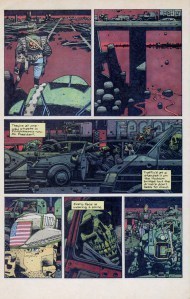 Sounds pretty John Wayne, huh? I actually mentally read that block of dialogue in Ed Gilbert’s voice (the voice of General Hawk in the 80’s GI Joe cartoon).
Sounds pretty John Wayne, huh? I actually mentally read that block of dialogue in Ed Gilbert’s voice (the voice of General Hawk in the 80’s GI Joe cartoon).
Except that of course, the duck and cover movies are all a lie.
Pilgrim is awakened on schedule twenty years after the nukes fly, and sets out in a Damnation Alley Landmaster style ATV, intermittently broadcasting to anyone left alive to listen. His only companions are a pair of bulky combat/heavy load robots named Abel and Baker, and a smaller ‘bot, Charlie, whose programming seems to include first aid, psychiatry, television, and generally acting as comic relief to keep Pilgrim sane with Hill Street Blues references, a jack of whiskey, and innocuous general encouragement.
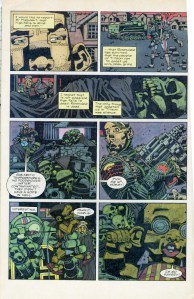 Pilgrim and the bots traverse a blasted, allegorical landscape in an episodic manner, encountering little more than ants and at one point, a mutated bald eagle. There is plenty of evidence that humans at least survived the initial strike, but none of it very encouraging. Pilgrim finds a maximum security prison where the warden ordered all the inmates executed. He finds highways choked with cars, each one jammed with old skeletons, and at one point, a pile of skulls with a grisly handwritten placard from a confessed cannibal professing his innocence of murder.
Pilgrim and the bots traverse a blasted, allegorical landscape in an episodic manner, encountering little more than ants and at one point, a mutated bald eagle. There is plenty of evidence that humans at least survived the initial strike, but none of it very encouraging. Pilgrim finds a maximum security prison where the warden ordered all the inmates executed. He finds highways choked with cars, each one jammed with old skeletons, and at one point, a pile of skulls with a grisly handwritten placard from a confessed cannibal professing his innocence of murder.
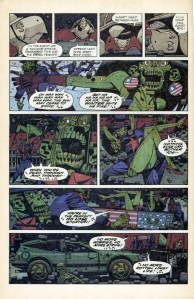 By the time the crew reaches the irradiated remains of New York, which has taken a direct hit, Pilgrim begins hallucinating. The weak point of the series for me comes with issue two’s prolonged delusional sequence in which skeletons dance and sing a macabre Broadway musical with lyrics like
By the time the crew reaches the irradiated remains of New York, which has taken a direct hit, Pilgrim begins hallucinating. The weak point of the series for me comes with issue two’s prolonged delusional sequence in which skeletons dance and sing a macabre Broadway musical with lyrics like
“When you’re flying through the air, think what you’ll save on taxi fare!”
It crosses over dark satire a bit into maudlin silliness at times.
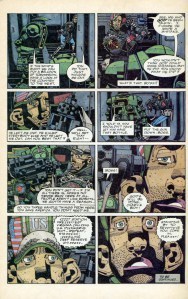 By the end, Pilgrim has given up hope and is suicidal, having already imagined the deaths of his wife and child over and over. But before he pulls the trigger on himself, the radio crackles with a cryptic, thrill inducing message addressed to Pilgrim’s US Deep Reserve Unit. Pilgrim heads out with renewed vigor in search of the source of the signal, somewhere among the eternally burning fires of the Virginia coal seams. In restless sleep, he dreams of an American heaven populated with a boy’s club of former US Presidents nudging each other about the inevitability of Armageddon.
By the end, Pilgrim has given up hope and is suicidal, having already imagined the deaths of his wife and child over and over. But before he pulls the trigger on himself, the radio crackles with a cryptic, thrill inducing message addressed to Pilgrim’s US Deep Reserve Unit. Pilgrim heads out with renewed vigor in search of the source of the signal, somewhere among the eternally burning fires of the Virginia coal seams. In restless sleep, he dreams of an American heaven populated with a boy’s club of former US Presidents nudging each other about the inevitability of Armageddon.
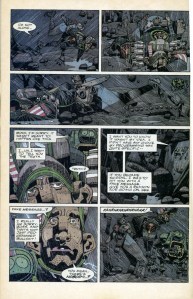 When a crumbling roadway gives way, flipping the ATV, Pilgrim flees out into a pouring toxic thunderstorm, desperate to continue his search, to validate his existence and find proof he’s not alone. At that point Charlie admits the message was a fake he was programmed to deliver should Pilgrim become suicidal.
When a crumbling roadway gives way, flipping the ATV, Pilgrim flees out into a pouring toxic thunderstorm, desperate to continue his search, to validate his existence and find proof he’s not alone. At that point Charlie admits the message was a fake he was programmed to deliver should Pilgrim become suicidal.
This would be a crushing Twilight Zone style ending, but in the final issue Pilgrim and company plod on, and come across an automated defense system protecting an underground laboratory, the blast doors cluttered with skeletons of those who died trying to get in. Blasting their way in, they find a nursery, and Charlie deduces the test subjects, pregnant women, fled into the lower levels. Despite the robots’ assurance that no life forms or signals are detected, Pilgrim insists on following their trail, and discovers a handwritten, badly misspelled journal of one of the autistic test subjects, who were undergoing an unspecified procedure when the war happened.
The woman, Melinda, tells a depressing story of herself and her unborn daughter Hope (because she hopes she will be smarter than she is). When one of the scientists opens the blast doors to check on the world post attack, he is dissolved in the chemically blazing air. This induces Melinda’s labor and she has her child. But she doesn’t name her Hope because –
“The doctors said something bad had happened and all hope was gone. They said it was the twilight of the world. So I called her Twilight.”
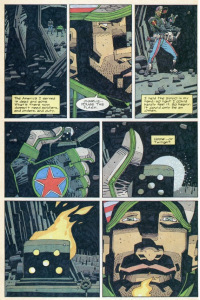 After eating all the food stores, the doctors resort to cannibalizing a baby and presumably each other. Twilight dies and Melinda leads the rest of the women down into the caverns beneath the facility with her prize zippo lighter. Pilgrim finds a half dozen skeletons out of the twenty test subjects, and finds a subterranean spring with evidence of past human habitation, along with Melinda’s zippo and the word AMERICA scrawled in the dirt, with an arrow pointing to a cave mouth. He posits that some of the women may have survived, that their children may have grown up somewhere out there, but wonders if he’s the one to go on looking for them.
After eating all the food stores, the doctors resort to cannibalizing a baby and presumably each other. Twilight dies and Melinda leads the rest of the women down into the caverns beneath the facility with her prize zippo lighter. Pilgrim finds a half dozen skeletons out of the twenty test subjects, and finds a subterranean spring with evidence of past human habitation, along with Melinda’s zippo and the word AMERICA scrawled in the dirt, with an arrow pointing to a cave mouth. He posits that some of the women may have survived, that their children may have grown up somewhere out there, but wonders if he’s the one to go on looking for them.
He orders Charlie and the bots to douse their external lights and flicks Melinda’s old zippo lighter, thinking Hope, or Twilight?
When a flame jumps out, it illuminates Pilgrim’s thin, hopeful smile.
And that’s the end.
 Artist Mike McMahon’s distorted, almost geometric human figures and the bold stars and stripes iconography on Pilgrim’s uniform remind me of Kevin O’Neal’s work on MARSHAL LAW, and the predominately gray and blue tones are effective if not very eyecatching at a glance. The inking however is superb and really pops on close inspection. Please click on the scans and get a good look at the wonderful detail. It really is a visually beautiful comic.
Artist Mike McMahon’s distorted, almost geometric human figures and the bold stars and stripes iconography on Pilgrim’s uniform remind me of Kevin O’Neal’s work on MARSHAL LAW, and the predominately gray and blue tones are effective if not very eyecatching at a glance. The inking however is superb and really pops on close inspection. Please click on the scans and get a good look at the wonderful detail. It really is a visually beautiful comic.
The John Wagner (who, with Arthur Ransom, did another of my favorite comics, BUTTON MAN) and Alan Grant script is pretty compelling, carrying what’s basically a one man stage show for four admittedly depressing issues and then managing to inject the dour subject matter with an undeniable and literal spark of humanistic hope in the end. This was 1990 and the Cold War that had inspired 99 Red Balloons, WAR GAMES, and MAD MAX 2 and a culture of perennial dread was ending. THE LAST AMERICAN perhaps came a little too late to seize the attention of the nuke fearing public, but only just. Comic books were just starting to become accepted in the greater whole of pop culture and were still for the main part sporting spandex so it’s possible the audience just wasn’t there for a serious comic about the futility of nuclear war. However, it’s a harrowing depiction of the true post-apocalypse, in the tradition of THE DAY AFTER and ON THE BEACH, and definitely deserves a second look if even as a sobering time capsule of the insanity of late eighties Soviet-American nuclear paranoia and Rocky IV flag waving.
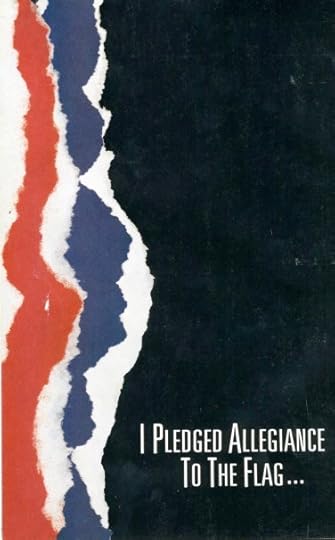 Apparently the collaborative team of Wagner and Grant suffered a breakup during the writing of THE LAST AMERICAN, and Wagner wrote issues 1 and 2, while Grant wrote 3 and 4. Comic.X put out a trade paperback edition collecting the whole series. I have the original issues so I can’t speak for the quality, but it seems like a good way to track this down if you’re having trouble. It’s worth a look.
Apparently the collaborative team of Wagner and Grant suffered a breakup during the writing of THE LAST AMERICAN, and Wagner wrote issues 1 and 2, while Grant wrote 3 and 4. Comic.X put out a trade paperback edition collecting the whole series. I have the original issues so I can’t speak for the quality, but it seems like a good way to track this down if you’re having trouble. It’s worth a look.


June 10, 2013
Where I’ll Be At WHC
Hey all, this weekend I’ll be at the World Horror Convention in New Orleans pitching the new novel and signing the old ones, so bring your babies to be kissed.
THURSDAY
7PM Genre Mashup Panel, Queen Anne Ballroom -
(from the program description) Hey, you got your horror in my romance fiction! Genre mash-ups aren’t just for sparkly vampires. Horror/noir and Lovecraftian mysteries are all the rage. Science fiction and fantasy fusions are as popular as ever. Dark magical realism is emerging from the depths. What else is out there and where is it going? Join our master mixology panel as they put on their alchemist hats and concoct some wild new genre recipes.
Moderator: Sunni Brock. Panelists: Edward M. Erdelac, Michael Boccacino, Roh Morgan, Robert Jackson Bennett
FRIDAY
1-2pm Signing Copies Of Terovolas at Journalstone Publishing’s table in the Dealer’s Room.
7-8pm – Mass signing of all my books.
And my wife and I will be attending the Stoker awards banquet on Saturday night, then chilling in the Big Easy all day Sunday.



